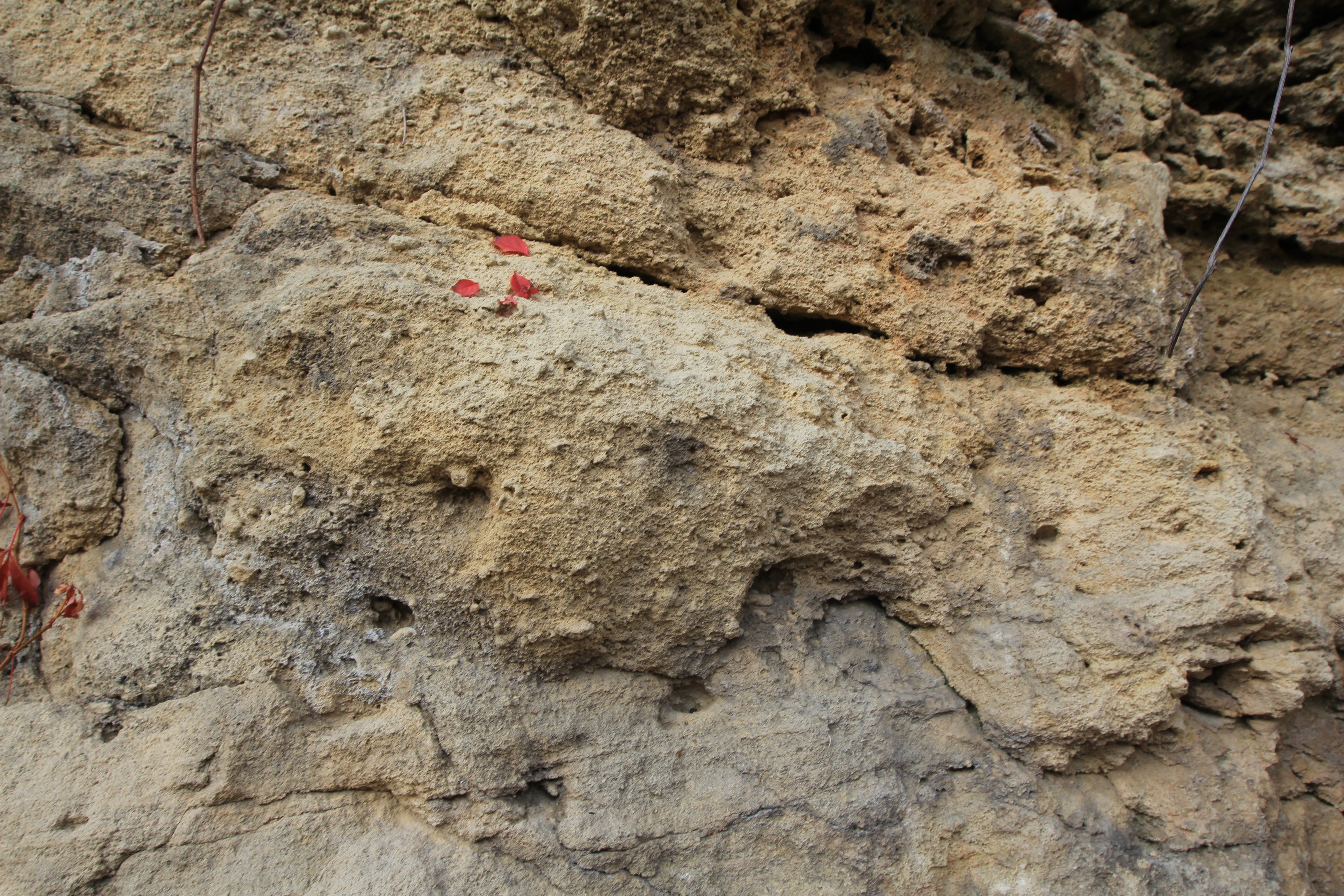
Contact between Skeletal sand grainstone and oncolite facies at Lime Kiln Park at Grafton Wisconsin. Yellow - Orange.
© The Field Museum - CC BY-NC
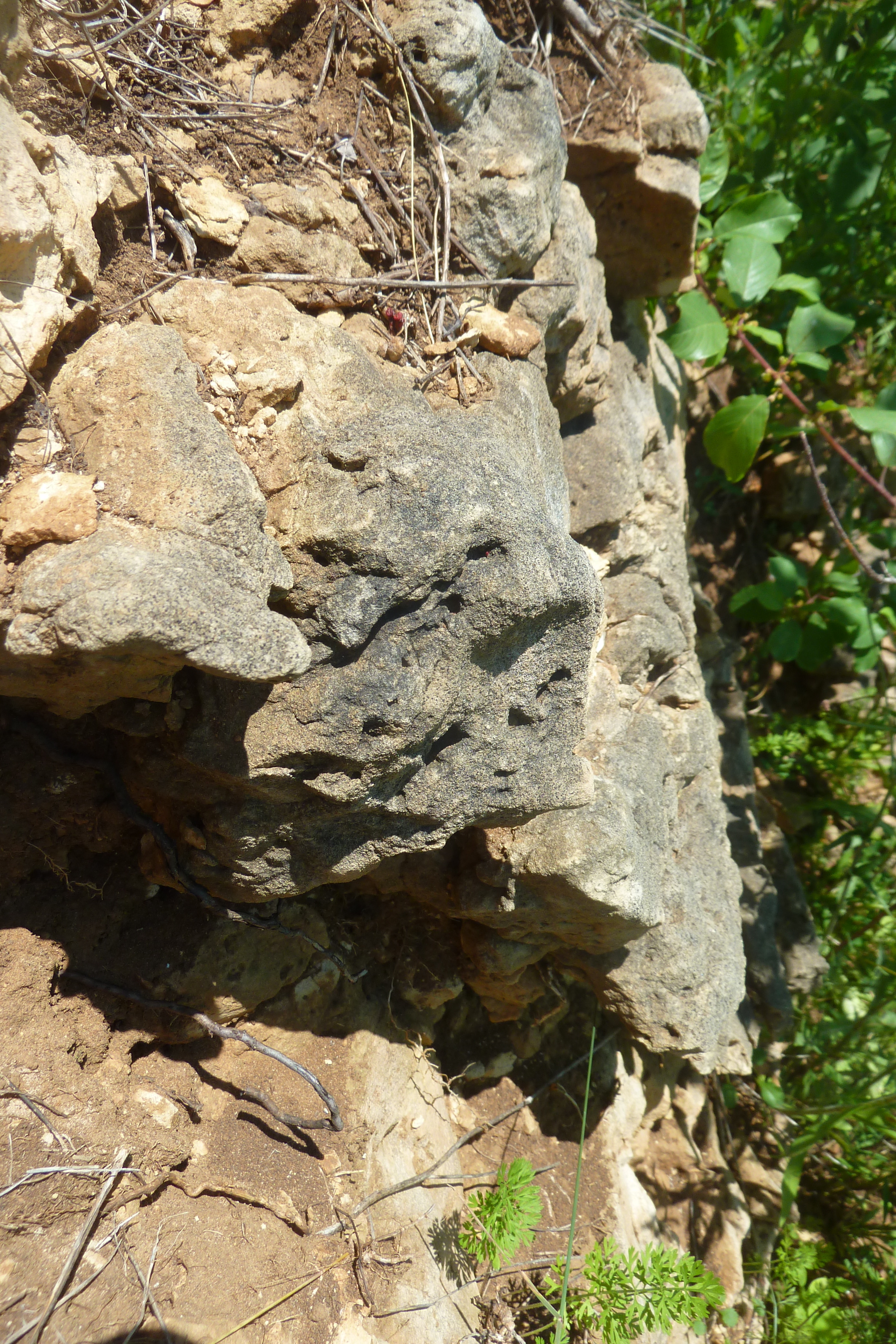
Post-reef Mudstone at Lime Kiln Park Grafton, Wisconsin
© The Field Museum - CC BY-NC
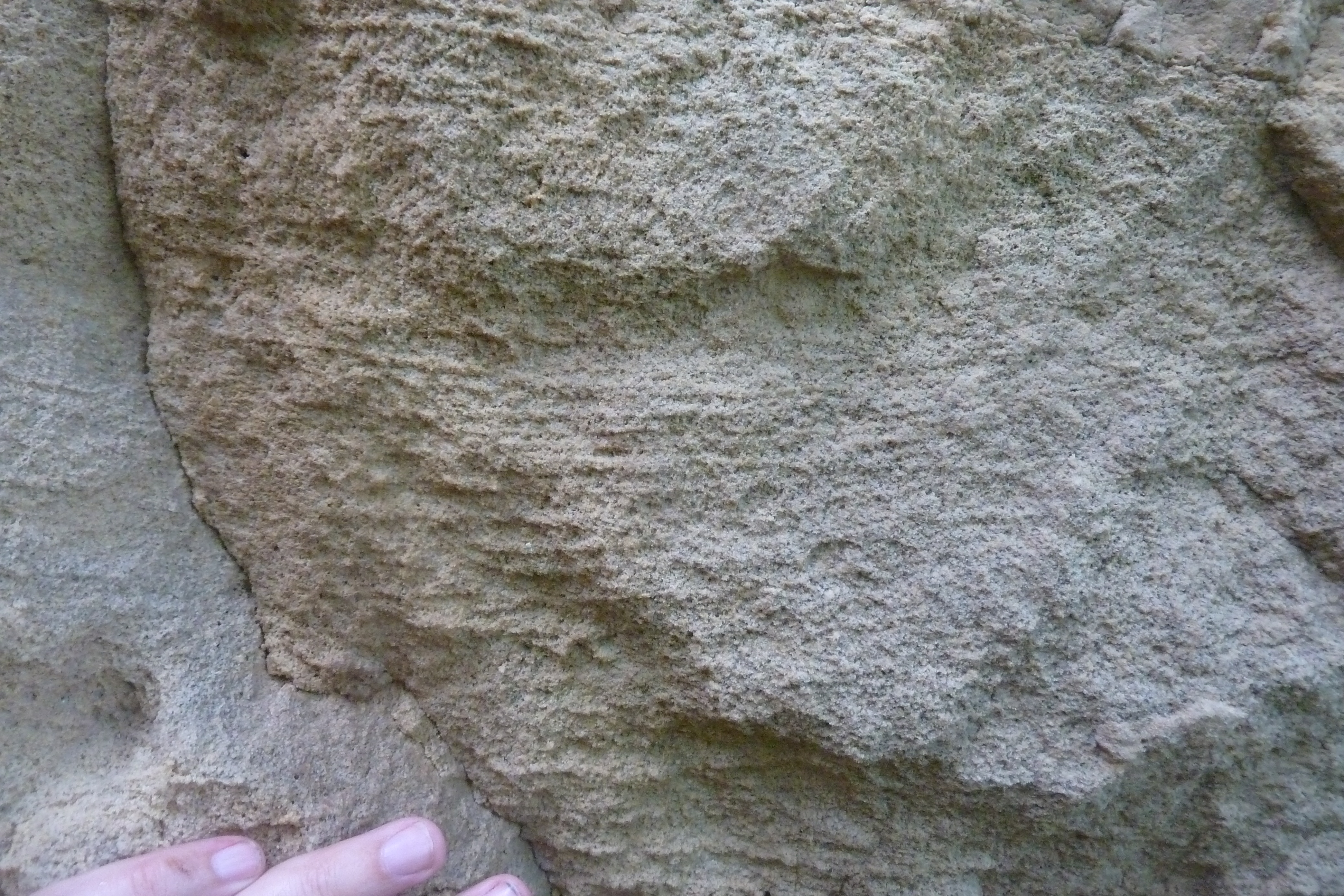
High energy skeletal sand grain grainstone at Lime Kiln, Grafton, Wisconsin. Silurian Reef
© The Field Museum - CC BY-NC
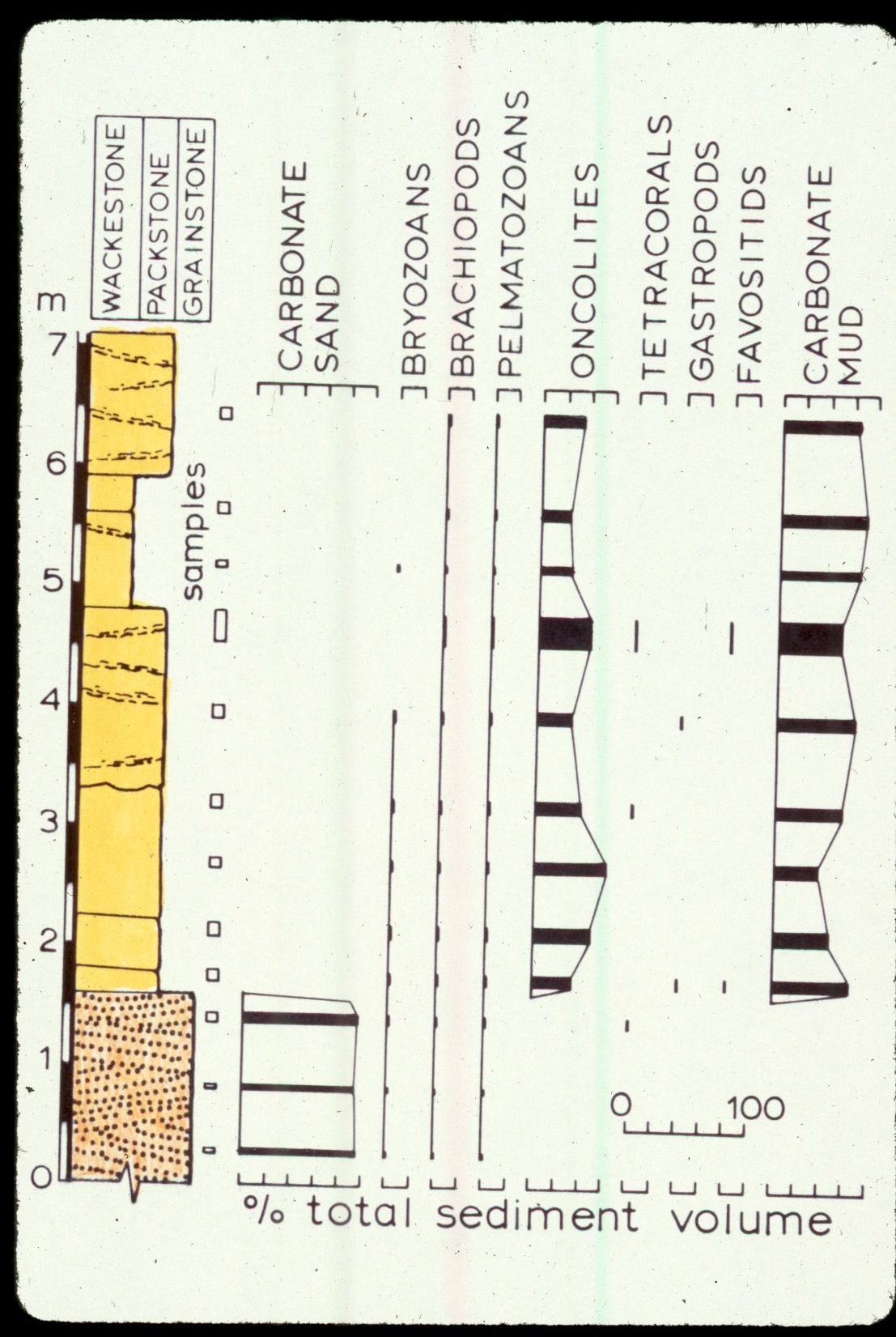
Cross section F at Lime Kiln Park, Grafton Wisconsin
© The Field Museum - CC BY-NC
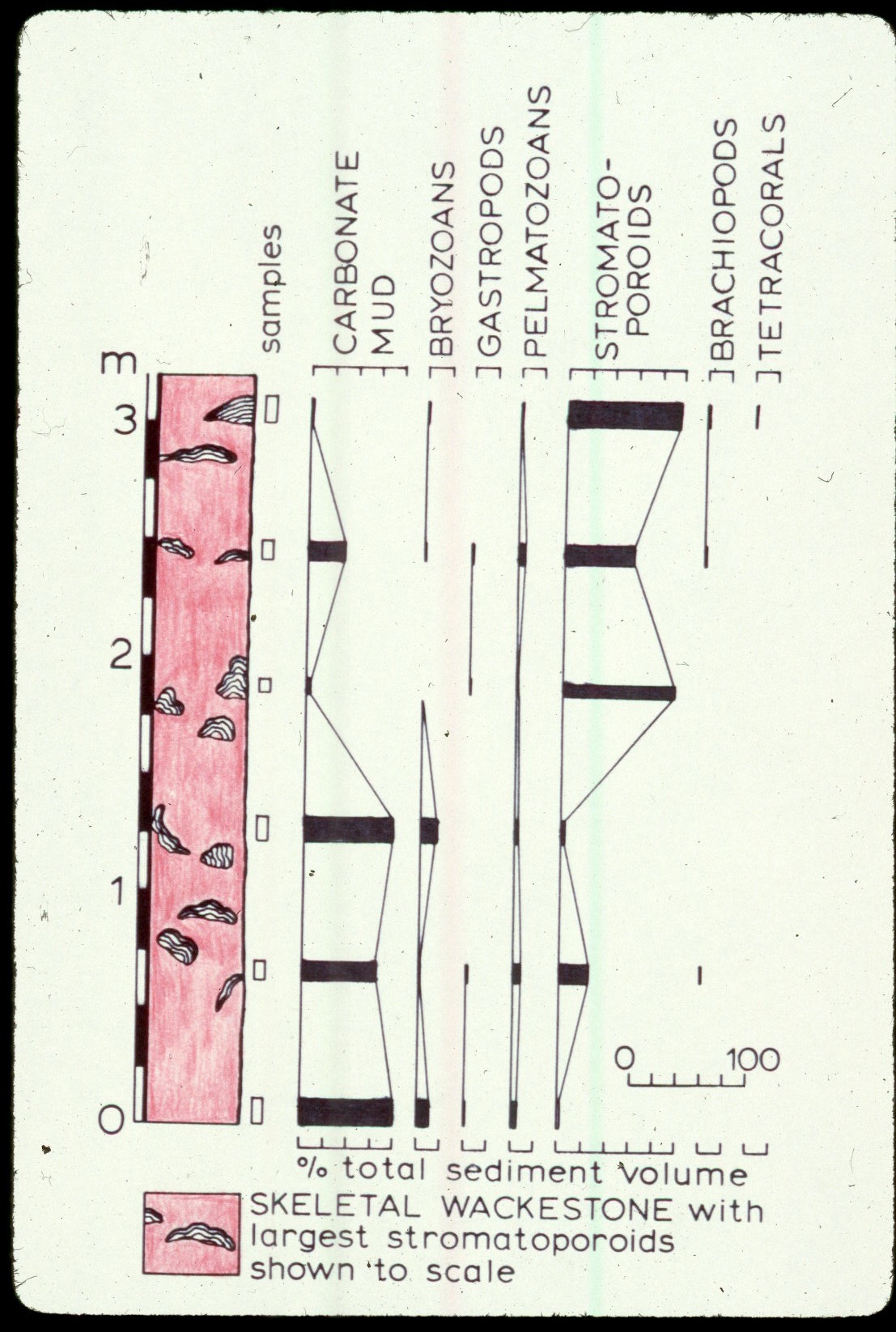
Cross section D at Lime Kiln Park, Grafton Wisconsin
© The Field Museum - CC BY-NC
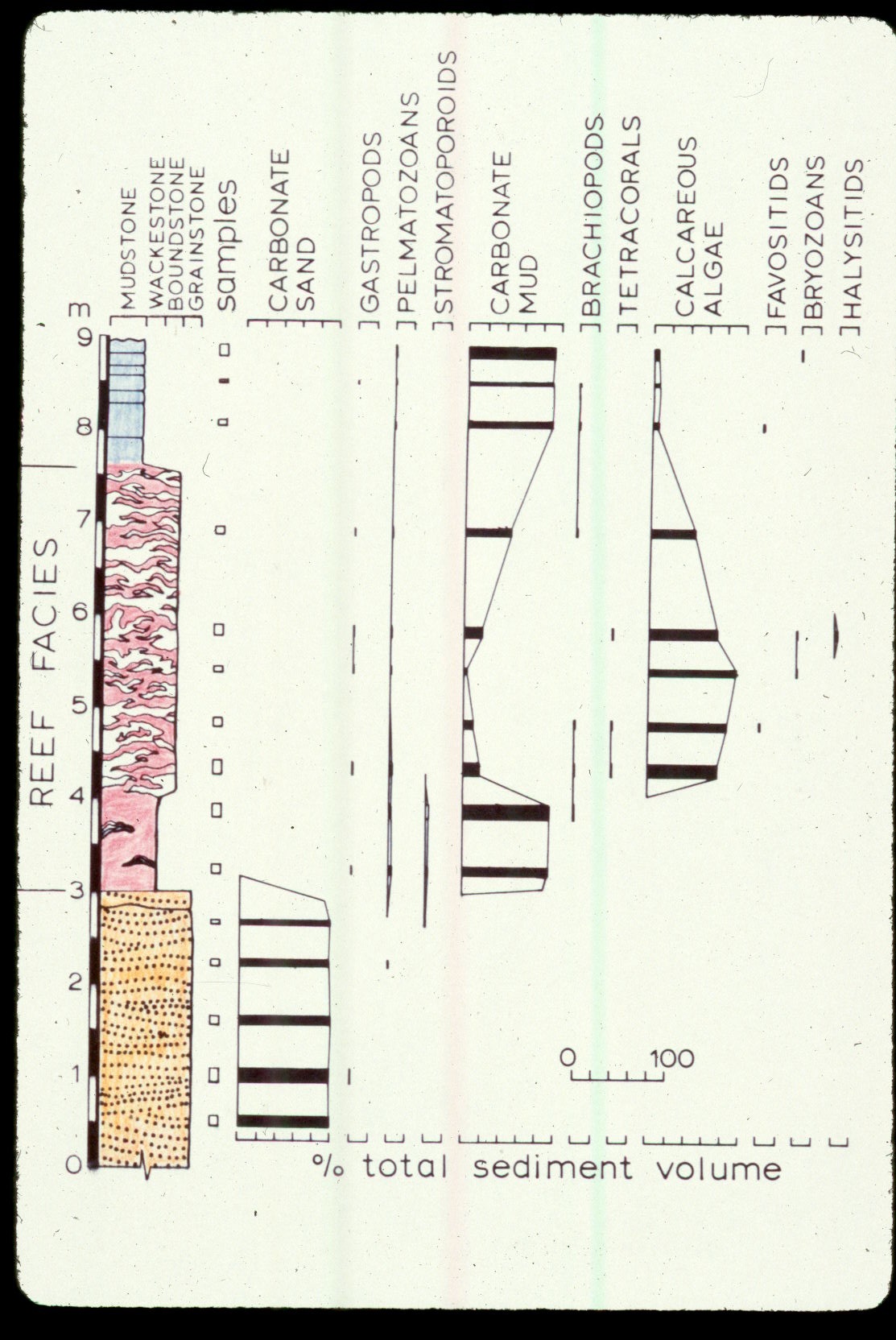
Measure sections like this one from the rock walls at Lime Kiln Park, Grafton, Wisconsin allow geologist to compare the different types of rocks and fossil at an area and see how they changed over time.
© The Field Museum - CC BY-NC
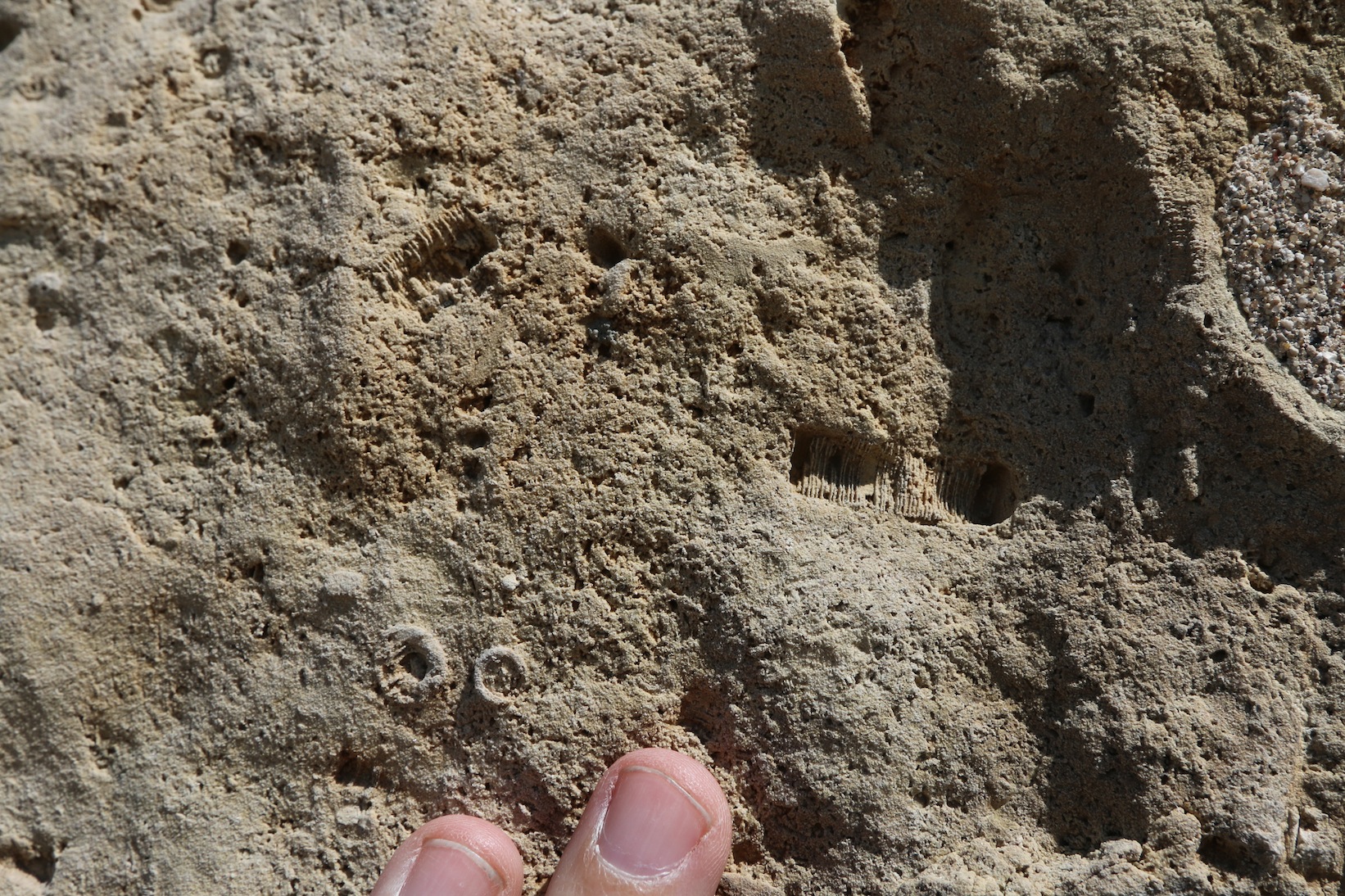
The Immaculate Conception Catholic Church in Saukville, WI was built in 1875 using Silurian stones with fossils probably from the Grafton Quarry at Lime Kiln Park.Building stone with fossil crinoid stems on West Side of the Church near front entrance.
© The Field Museum - CC BY-NC

The Immaculate Conception Catholic Church in Saukville, WI was built in 1875 using Silurian stones with fossils probably from the Grafton Quarry at Lime Kiln Park. Photo shows close up of favositid coral in Church wall. Coral is about 2 inches wide. Stone is about 6 feet from ground and on the West side of the Church near front entrance.
© The Field Museum - CC BY-NC
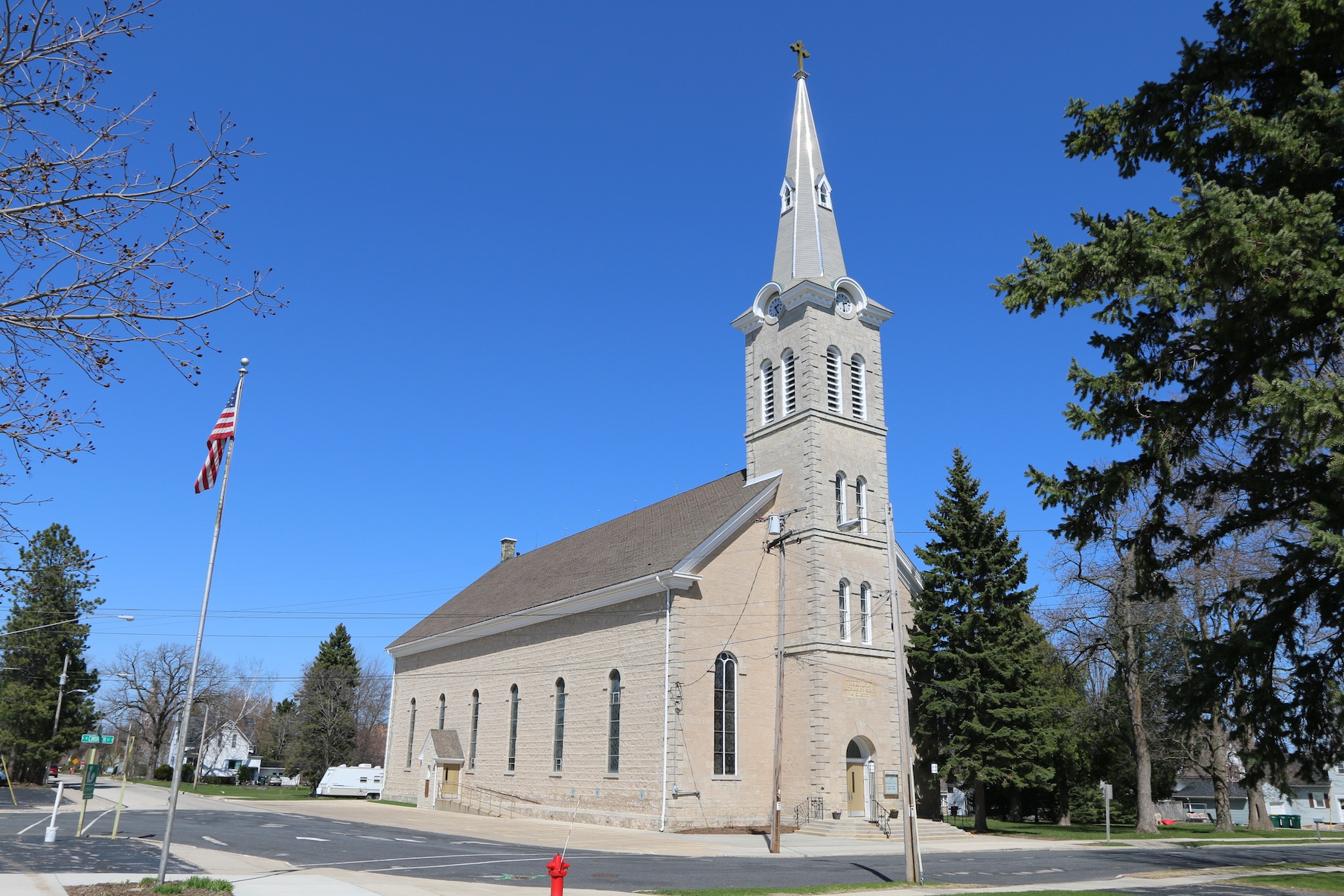
The Immaculate Conception Catholic Church in Saukville, WI was built in 1875 using Silurian stones with fossils probably from the Grafton Quarry at Lime Kiln Park.
© The Field Museum - CC BY-NC

Silurian orthoceras nautiloid cephalopods at quarry in Lime Kiln Park, Grafton, Wisconsin.
© The Field Museum - CC BY-NC
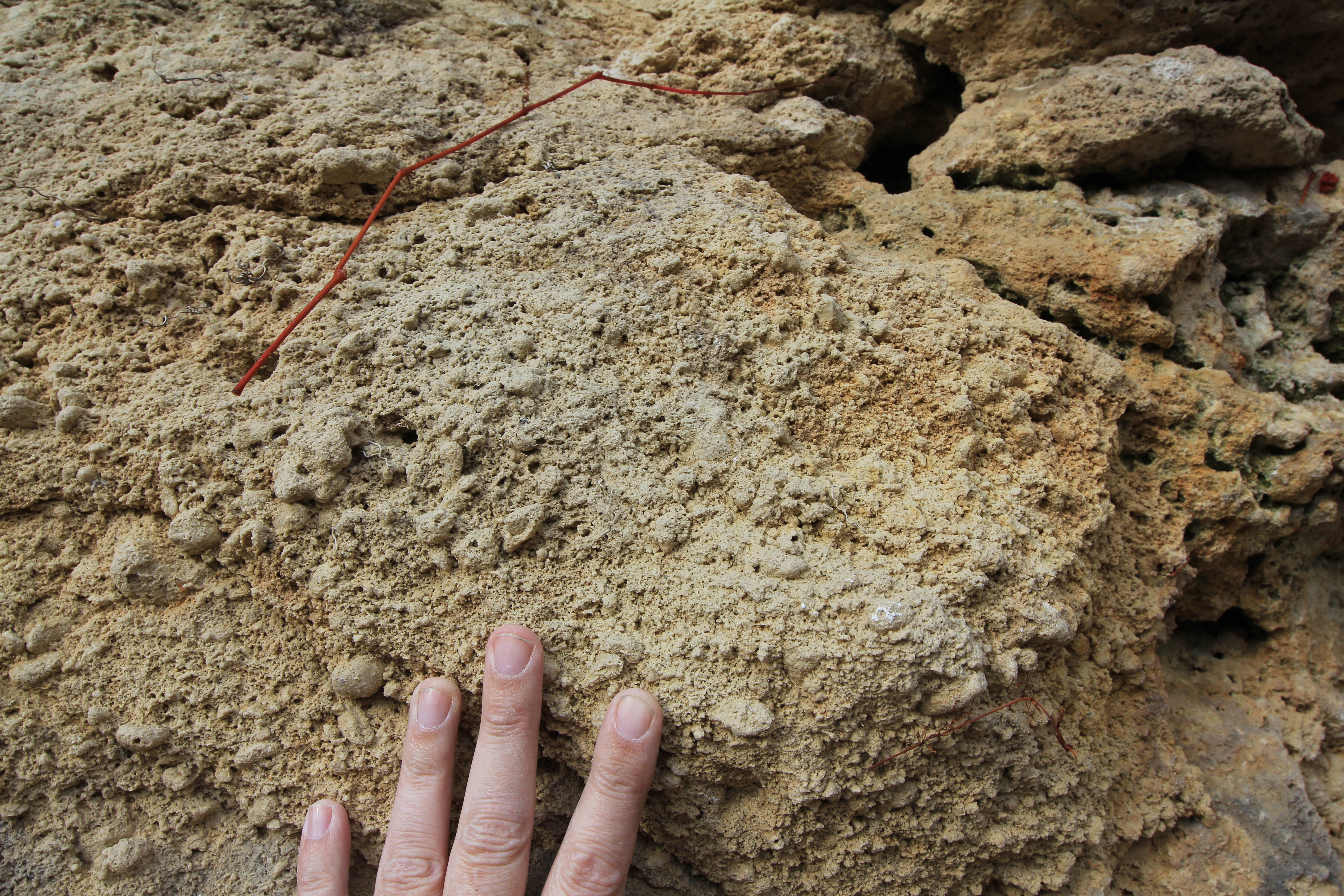
Silurian reef oncolite packstone at quarry in Lime Kiln Park, Grafton, Wisconsin.
© The Field Museum - CC BY-NC
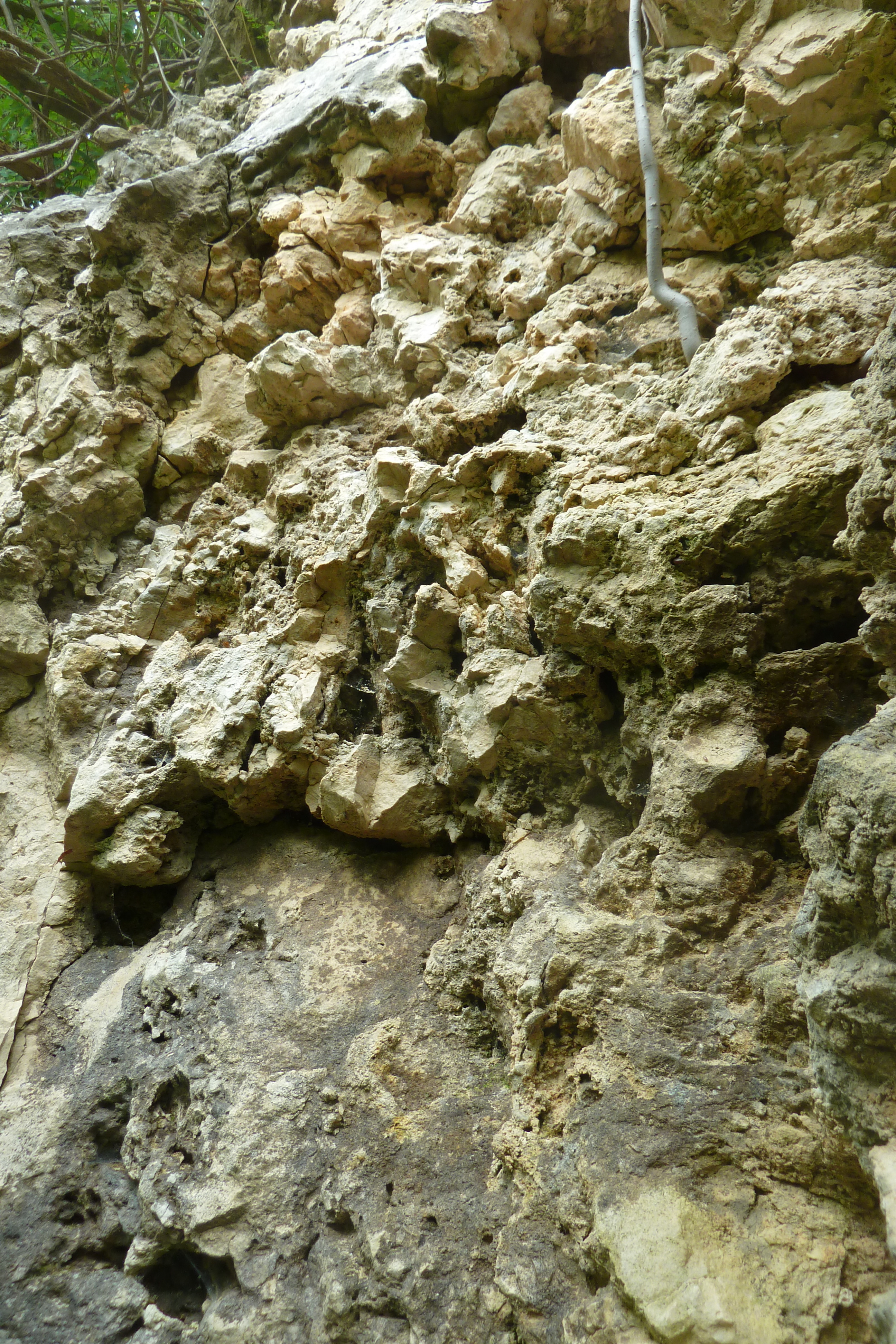
Silurian reef boundstone at quarry in Lime Kiln Park, Grafton, Wisconsin. Reef rock shows no bedding and has a blocky, fractured appearance. Stromatoporoids, corals and other fossils are locally abundant. Microbial organisms, probably algae or bacteria, grew around shells and mud and bound the reef sediment together.
© The Field Museum - CC BY-NC
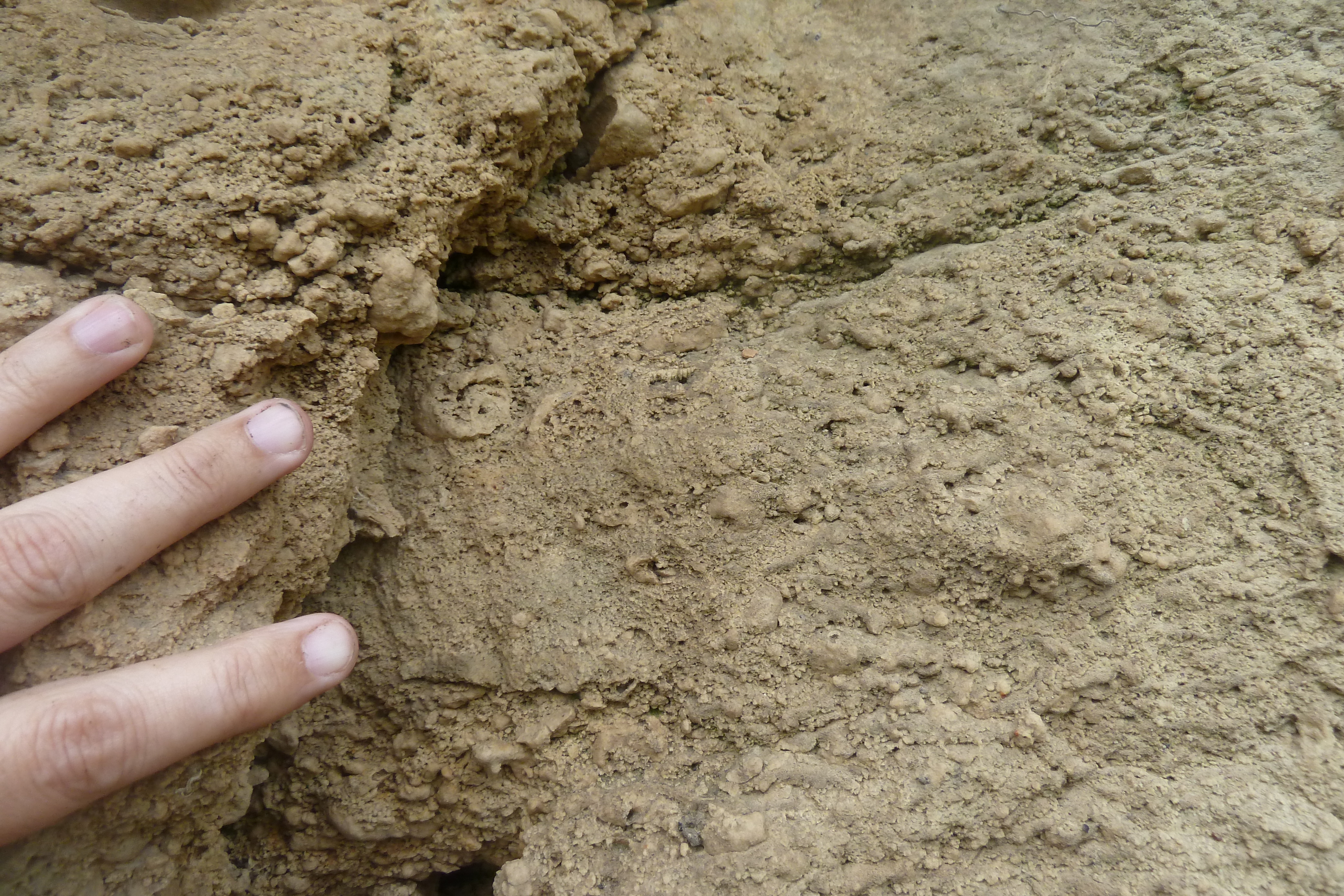
Oncolite packstone at Silurian quarry in Lime Kiln Park. Interreef deposits consist of thick beds of fine-grained, partly cross-bedded dolostone with abundant oncolites, which are spherical to ellipsoidal particles formed by concentric layers of microbial organisms. Oncolites indicate agitated waters where particles are rolled frequently over the seafloor, and they also indicate shallow depths where sunlight is available for photosynthesis.
© The Field Museum - CC BY-NC

Carbonate skeletal grainstone at Silurian quarry in Lime Kiln Park, Grafton, Wisconsin.
© The Field Museum - CC BY-NC
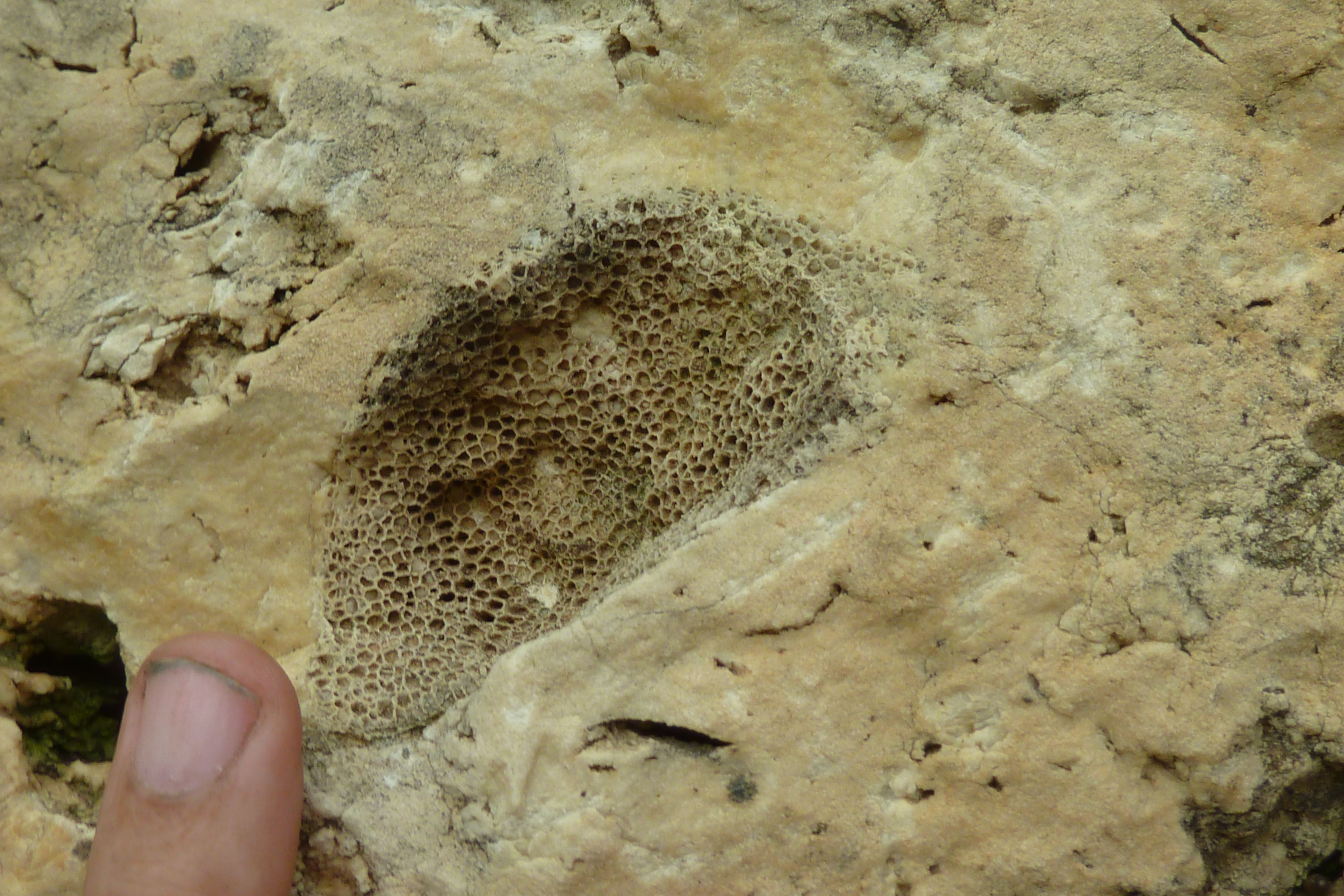
Silurian reef favositid tabulate coral at quarry in Lime Kiln Park, Grafton, Wisconsin.
© The Field Museum - CC BY-NC
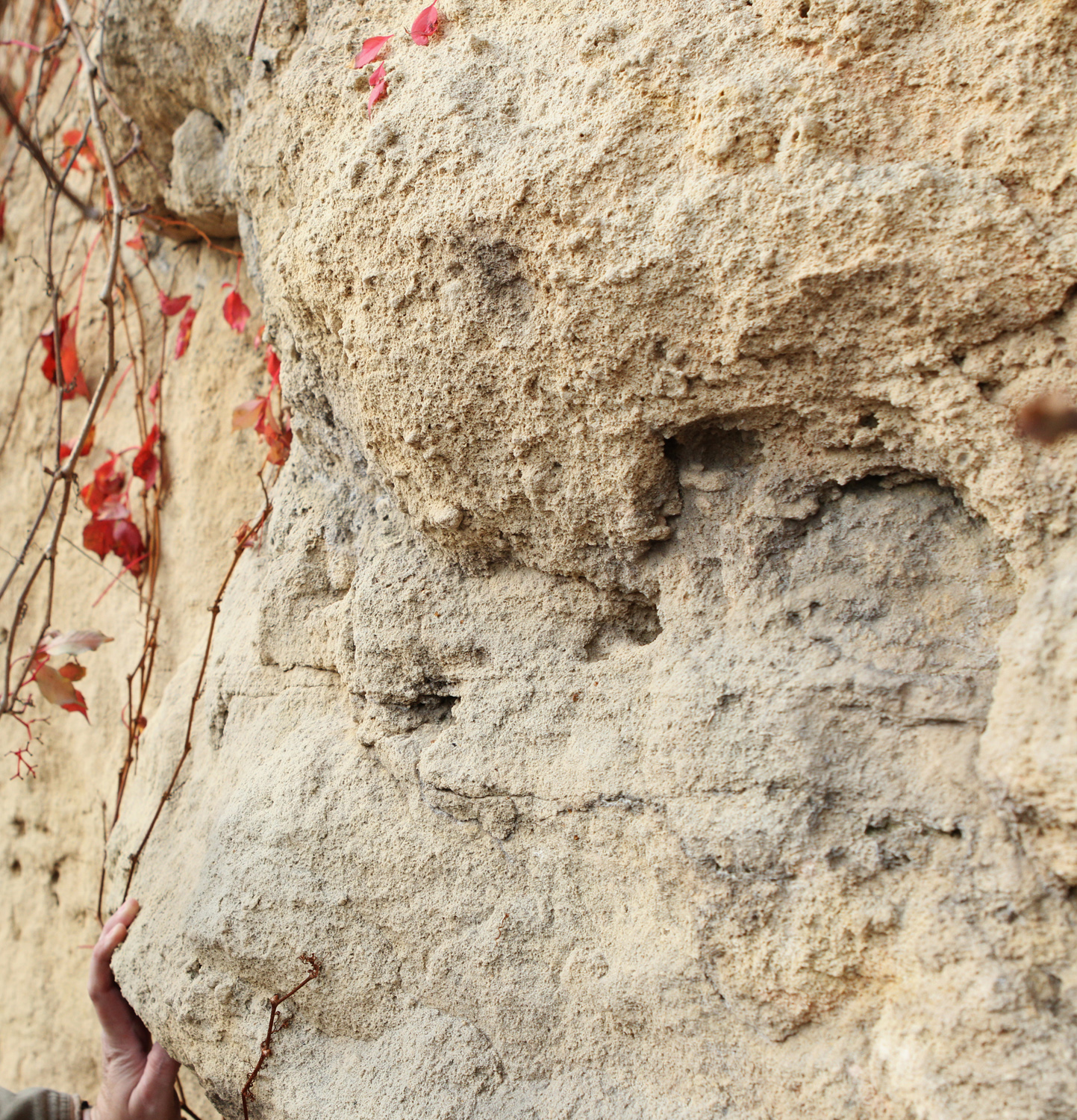
Contact between cross bedded grain stone and oncolite grainstone at Lime Kiln Park. Prereef deposits consist of coarse-grained dolostone composed of visible dolomite crystals, fossil shell debris, and fewer whole shells. This rock represents an original sediment of carbonate sand. The rock shows extensive cross-bedding, a feature that indicates a shallow seafloor on which sediment particles were moved frequently by waves and currents.
© The Field Museum - CC BY-NC
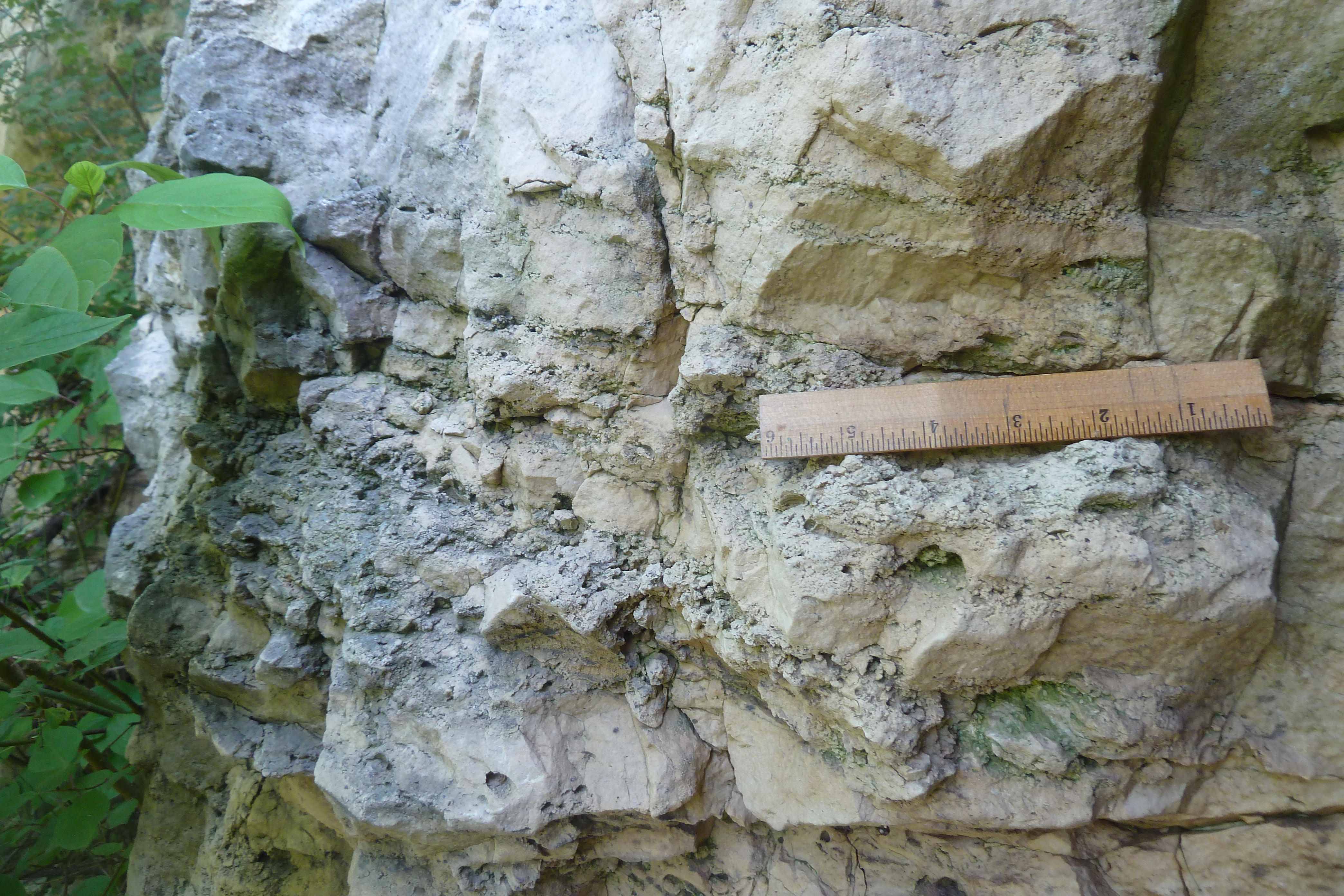
Interbedded oncolite packstone with fine grain micrite at Silurian reef quarry in Lime Kiln Park, Grafton, Wisconsin. Post-reef deposits consist of thin beds of fine-grained dolostone that are composed of dolomite crystals too small to be seen with the naked eye. This rock represents an original sediment of carbonate mud. Gastropods and other fossils are present but not abundant.
© The Field Museum - CC BY-NC
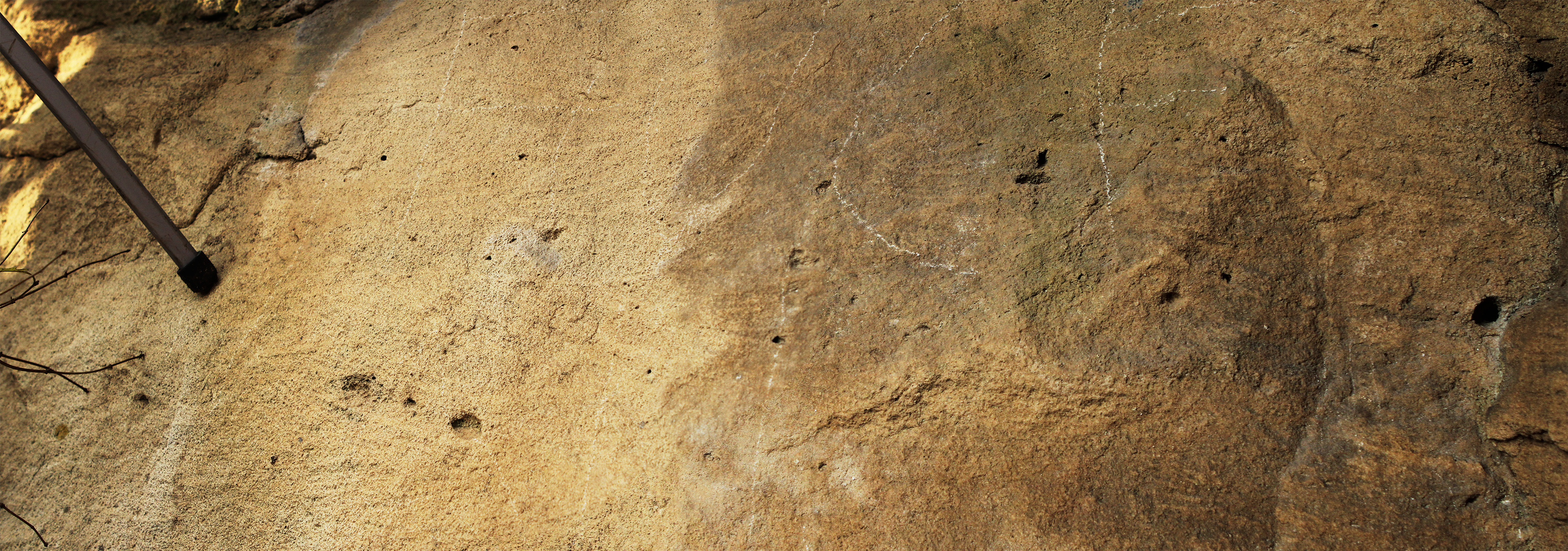
Cross bedding deposits at Lime Kiln Park, Grafton, Wisconsin
© The Field Museum - CC BY-NC
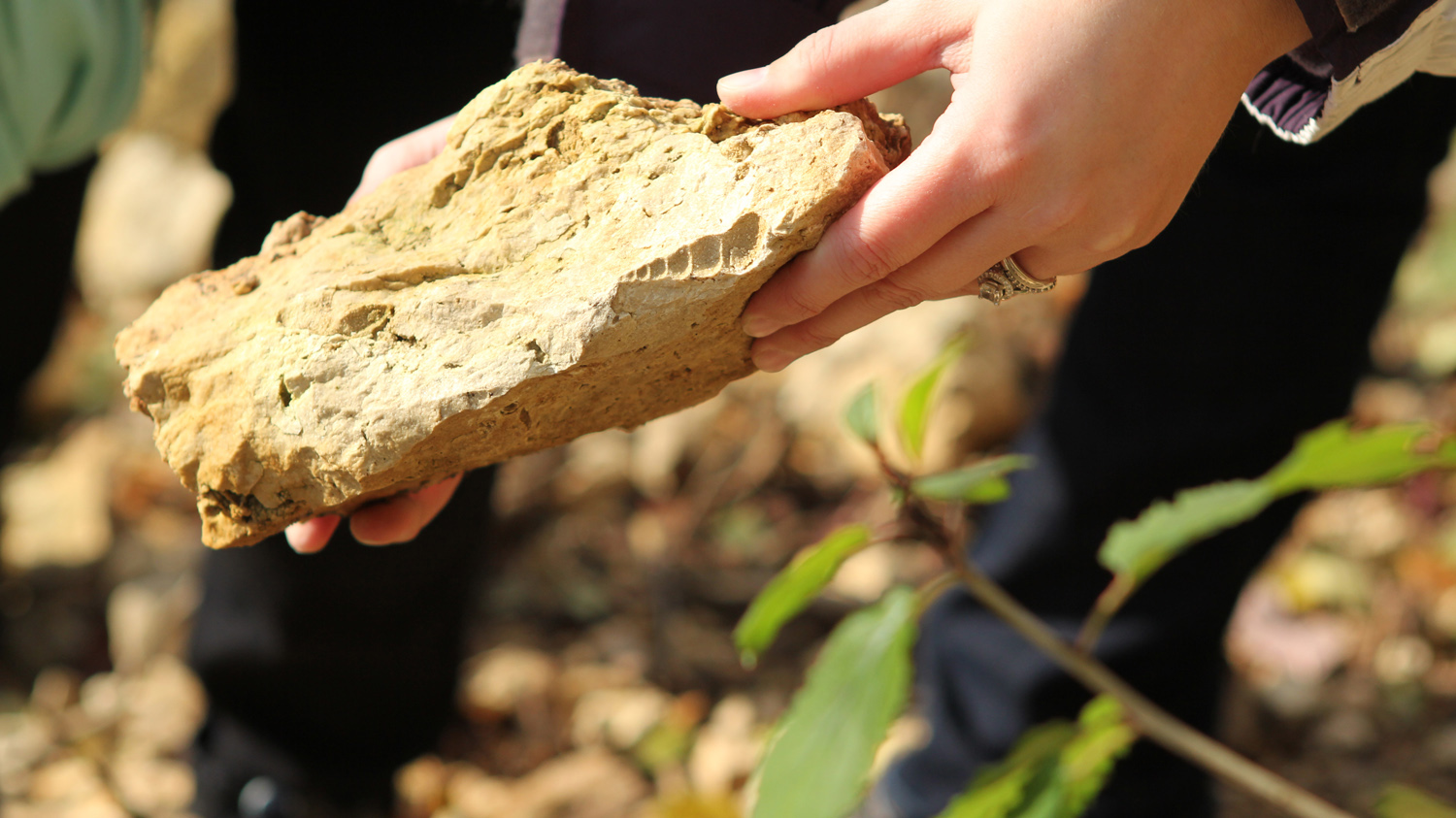
Gastropod fossil from Pre-reef deposits at Lime Kiln Park, Grafton, Wisconsin. Taken during November 2013 trip led by Paul Mayer to Silurian reef sites near Grafton, WI.
© The Field Museum - CC BY-NC

Cross-bedding in pre-reef deposits. Paul Mayer for scale.
© The Field Museum - CC BY-NC

Contact of reef (nodular rock above) and underlying pre-reef deposits (smooth at level with Tom) at measured section C.
© The Field Museum - CC BY-NC
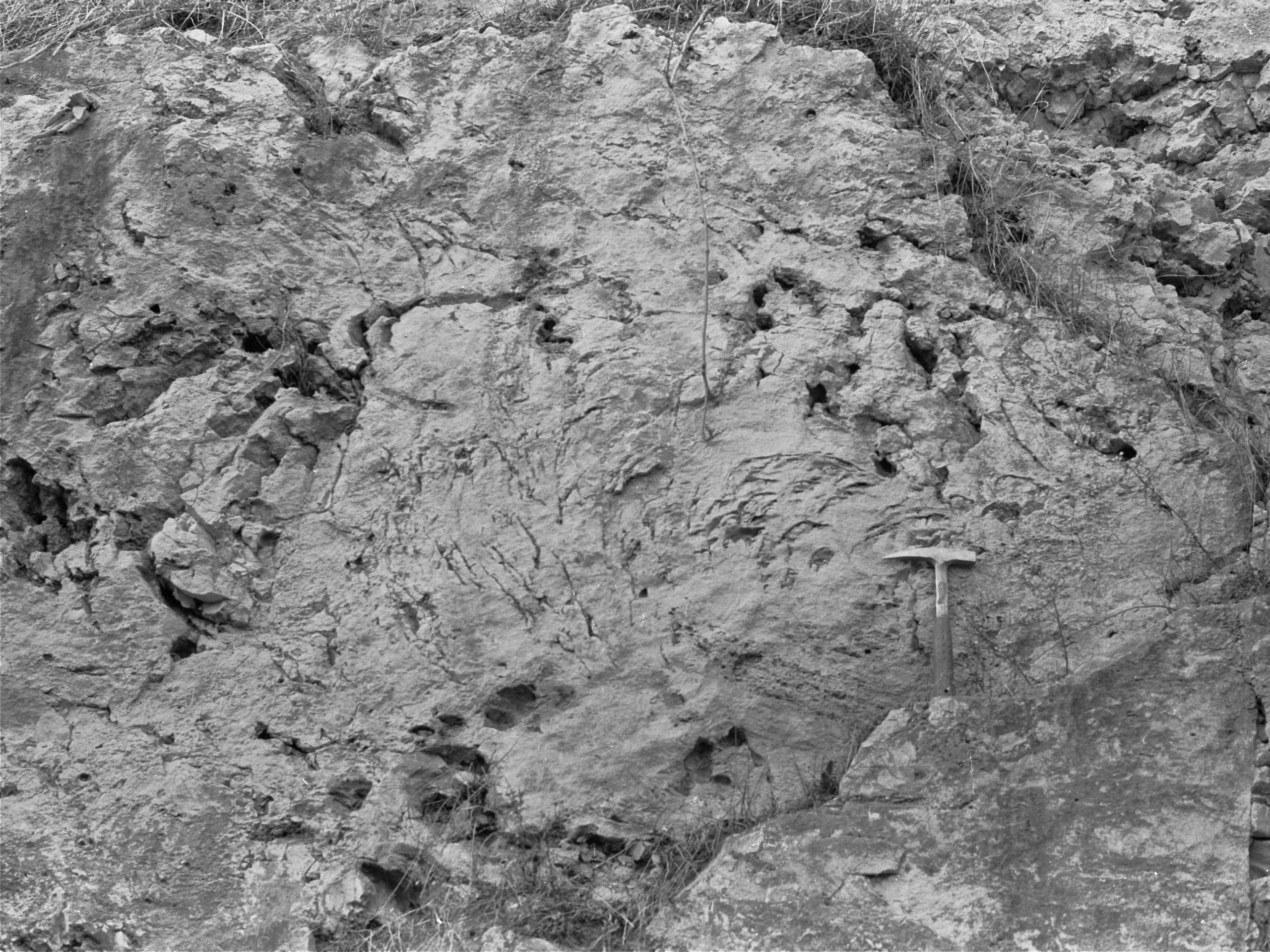
This outcrop indicates movement of unbound mud down the side of the reef. As indicated by curved fracture patterns (cracks in the rock), movement of material was downslope from right to left.
© The Field Museum - CC BY-NC
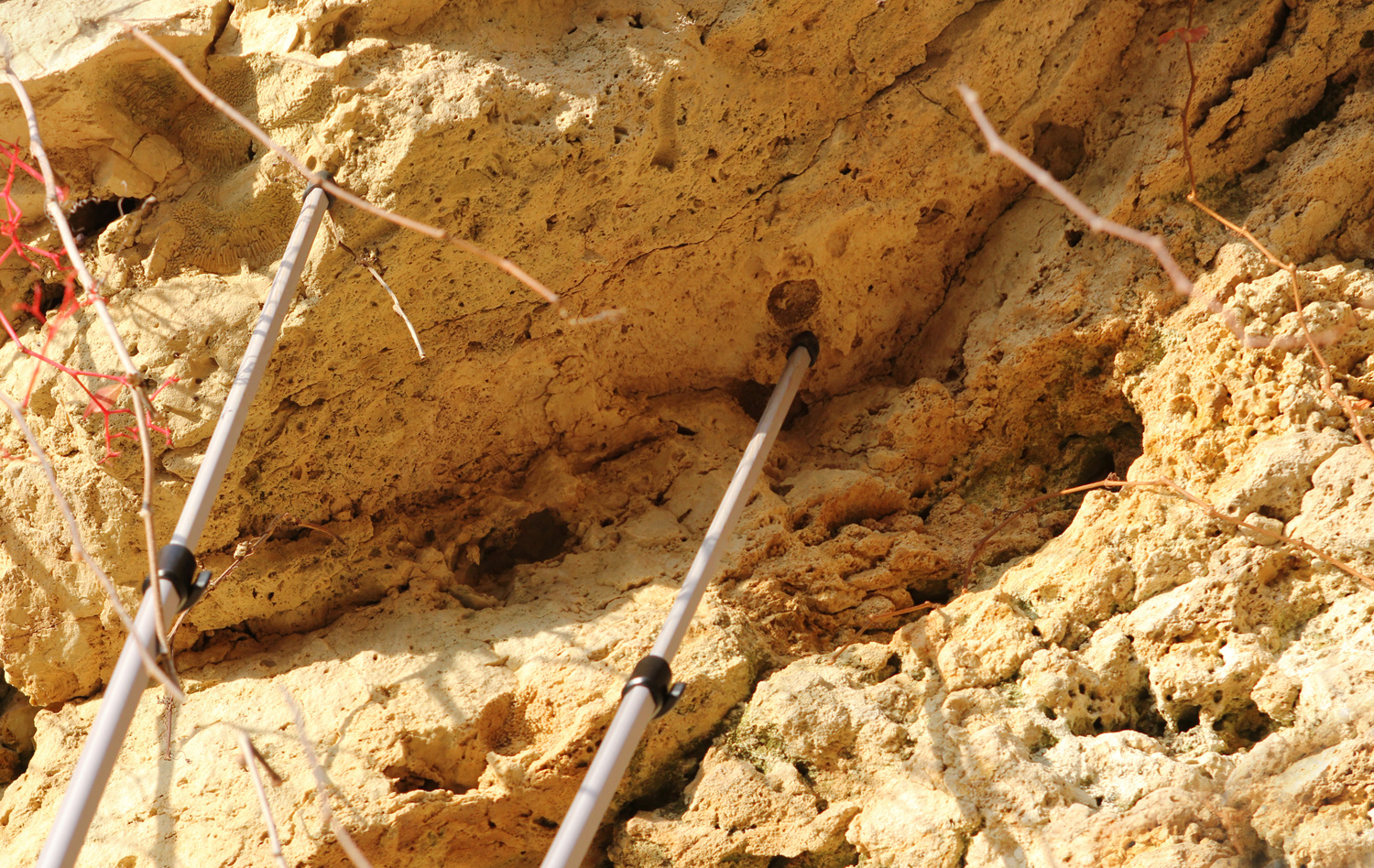
Close-up of reef at measured section B. Although difficult to see, stromatoporoids are abundant in this rock. Also visible are a several tabulate coral. A large one is visible, along with gastropod fossils, on the left edge of the image. This outcrop indicates movement of unbound mud down the side of the reef.
© The Field Museum - CC BY-NC
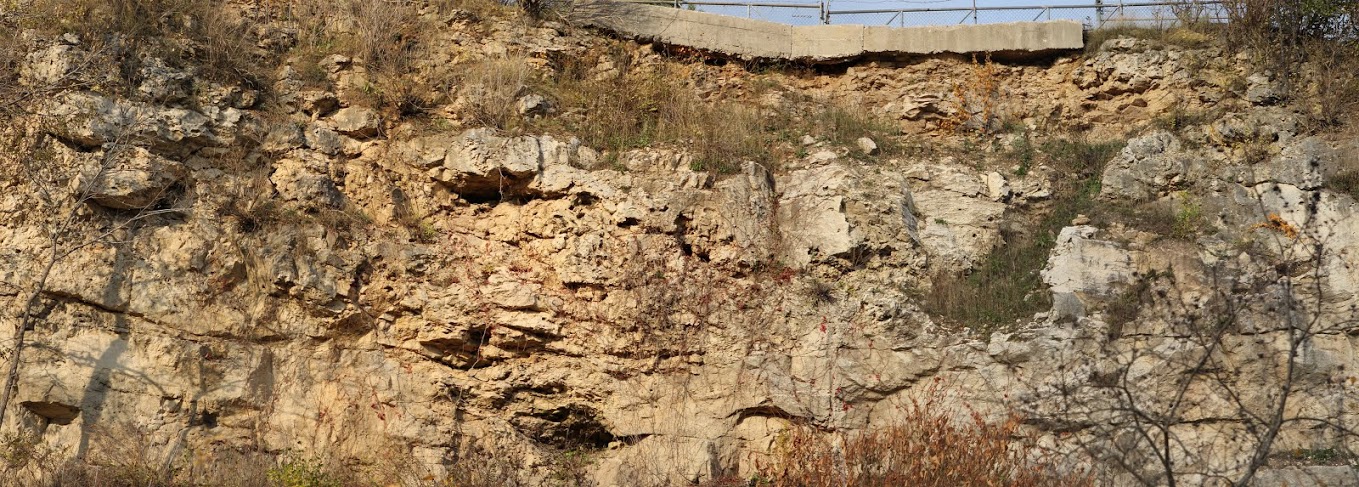
Panaroma image of rock wall at Lime Kiln Park in Grafton showing in situ Silurian reefs and other silurian deposits.
© The Field Museum - CC BY-NC
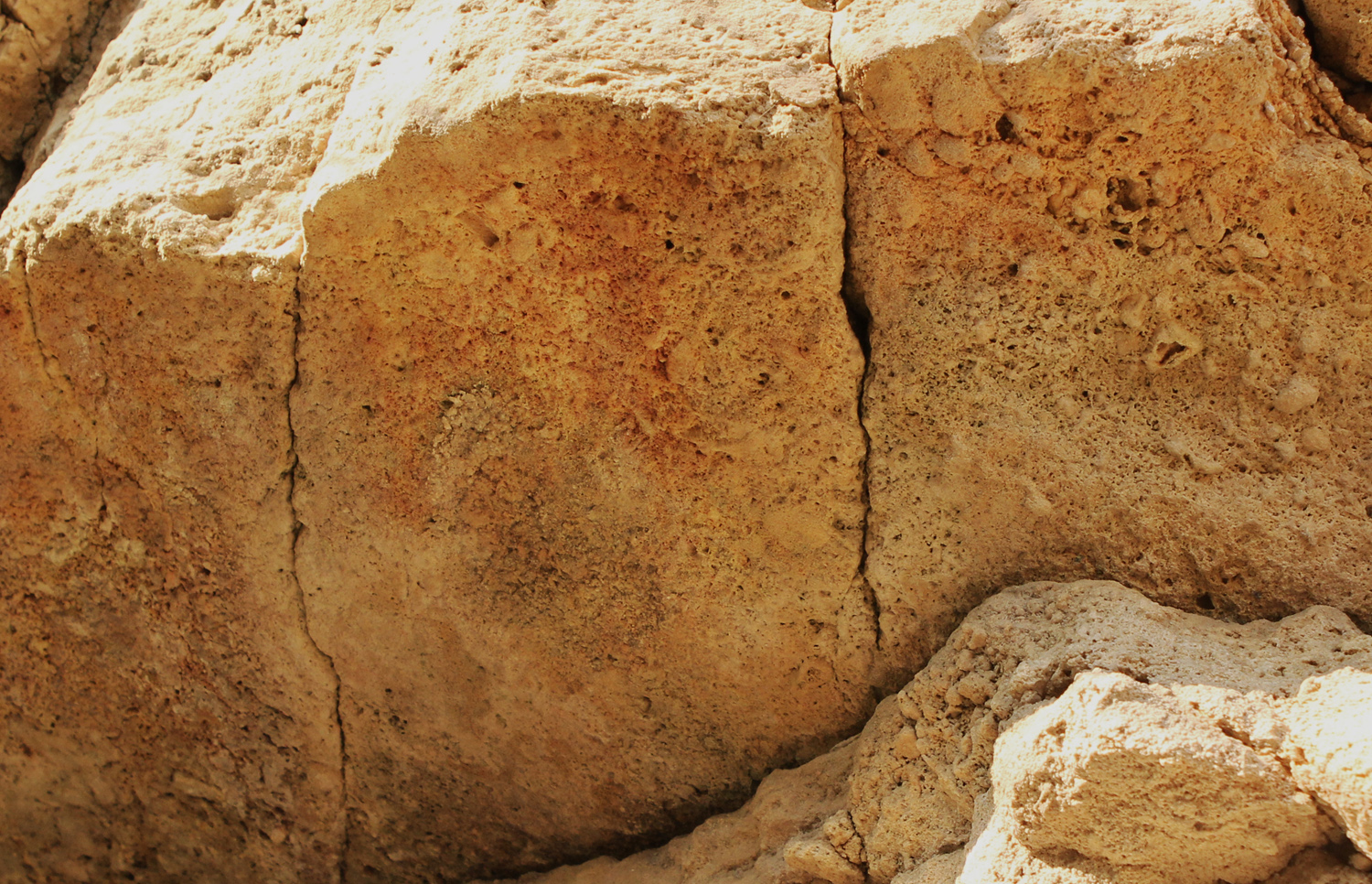
Grafton Silurian Reef site overhang close-up. Fossils in the rock. Taken during November 2013 trip led by Paul Mayer to Silurian reef sites near Grafton, WI.
© The Field Museum - CC BY-NC
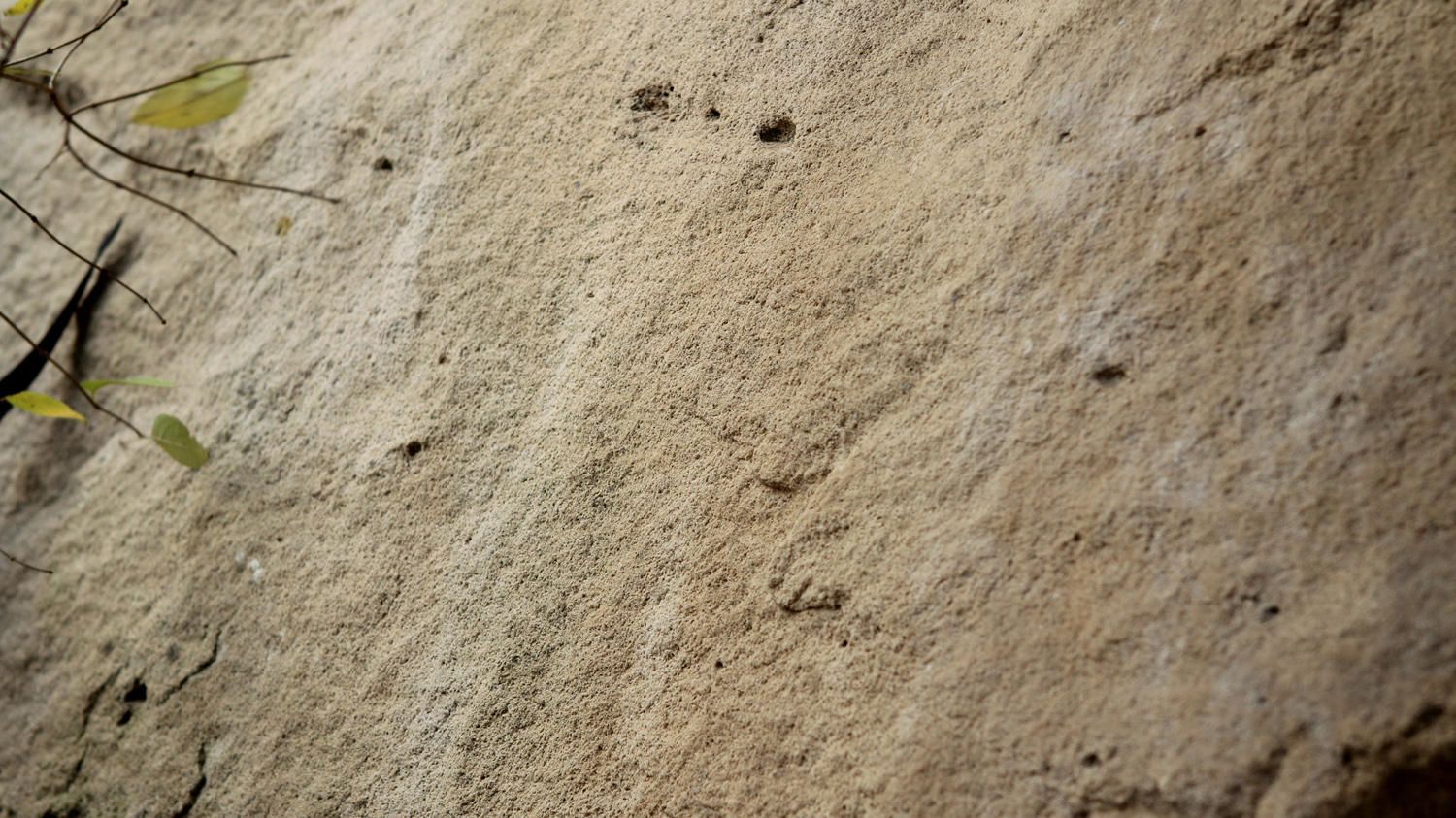
Grafton Silurian Reef site close-up of coarse textured rock. Taken during November 2013 trip led by Paul Mayer to Silurian reef sites near Grafton, WI.
© The Field Museum - CC BY-NC

Grafton Silurian Reef site vertical panorama. Paul Mayer pointing out different fossils with pole. Taken during November 2013 trip led by Paul Mayer to Silurian reef sites near Grafton.
© The Field Museum - CC BY-NC

Grafton Silurian Reef site vertical panorama showing differences between fossil layers. Taken during November 2013 trip led by Paul Mayer to Silurian reef sites near Grafton, WI.
© The Field Museum - CC BY-NC

Grafton Silurian Reef site close-up. Paul points out the coarse texture of the rock. Taken during November 2013 trip led by Paul Mayer to Silurian reef sites near Grafton, WI.
© The Field Museum - CC BY-NC

Grafton Silurian Reef site view with museum staff (left to right) PJ Burke, two staff members from MPM, and Sharon Grant. Taken during November 2013 trip led by Paul Mayer to Silurian reef sites near Grafton, WI.
© The Field Museum - CC BY-NC

In the quarry wall at Lime Kiln Park you can see several different facies including Silurian reefs, skeletal mudstones, oncolite packstones, grainstones and post reef deposits. As indicated by fracture patterns (cracks in the rock), movement of material was downslope from right to left. Contact of reef (in shadow) and underlying pre-reef deposits (sunlit) at measured section C.
© The Field Museum - CC BY-NC
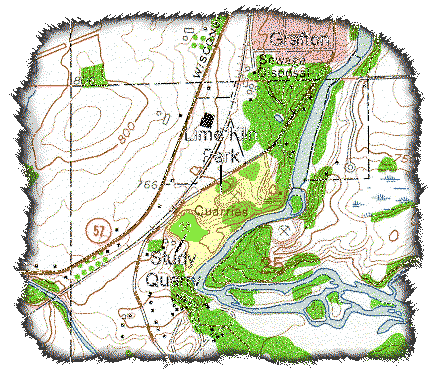
Topographic map of Grafton Wisconsin. We will study the Silurian reef exposed in the southwestern quarry in Lime Kiln Park. This quarry is highlighted in lime green on the topographic map
© The Field Museum - CC BY-NC
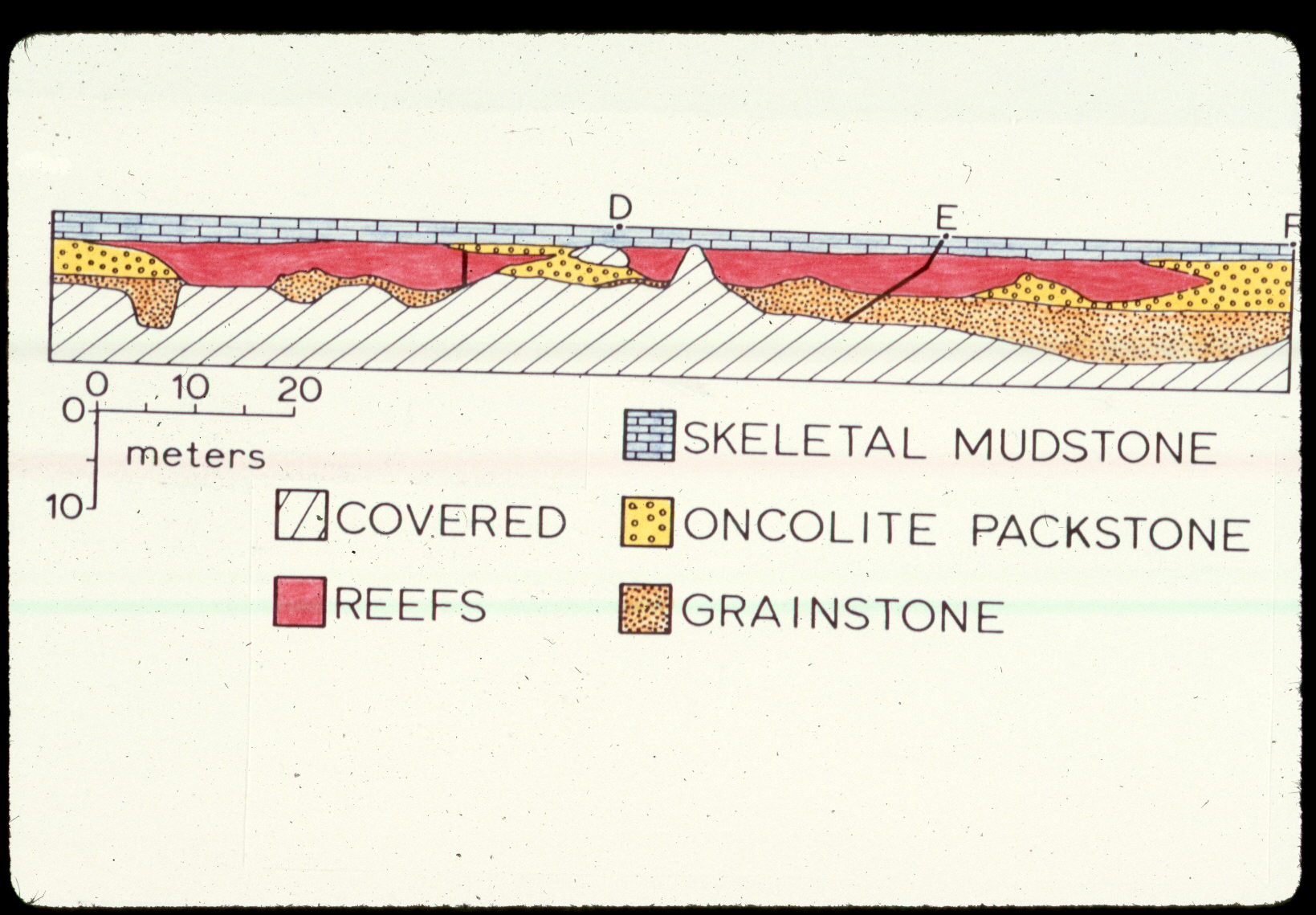
Cross section of bluffs at Lime Kiln Park, Grafton, Wisconsin showing Silurian reefs and other deposits.
© The Field Museum - CC BY-NC

This is a cross section sketch showing reef locations and other deposits at Lime Kiln Park, Grafton, Wisconsin. When rock strata vary laterally in thickness, composition, or other features, geologists construct a cross-section to document this variation. Cross-sections may be recorded as a simple sketch, a mosaic of overlapping photos, or a series of measured sections along the face of a quarry or other outcrop. Cross-sections are particularly important in studies in ancient reefs. This example from Lime Kiln Park, constructed by tape measurements along the quarry face, shows the relation between reef and interreef deposits.
© The Field Museum - CC BY-NC
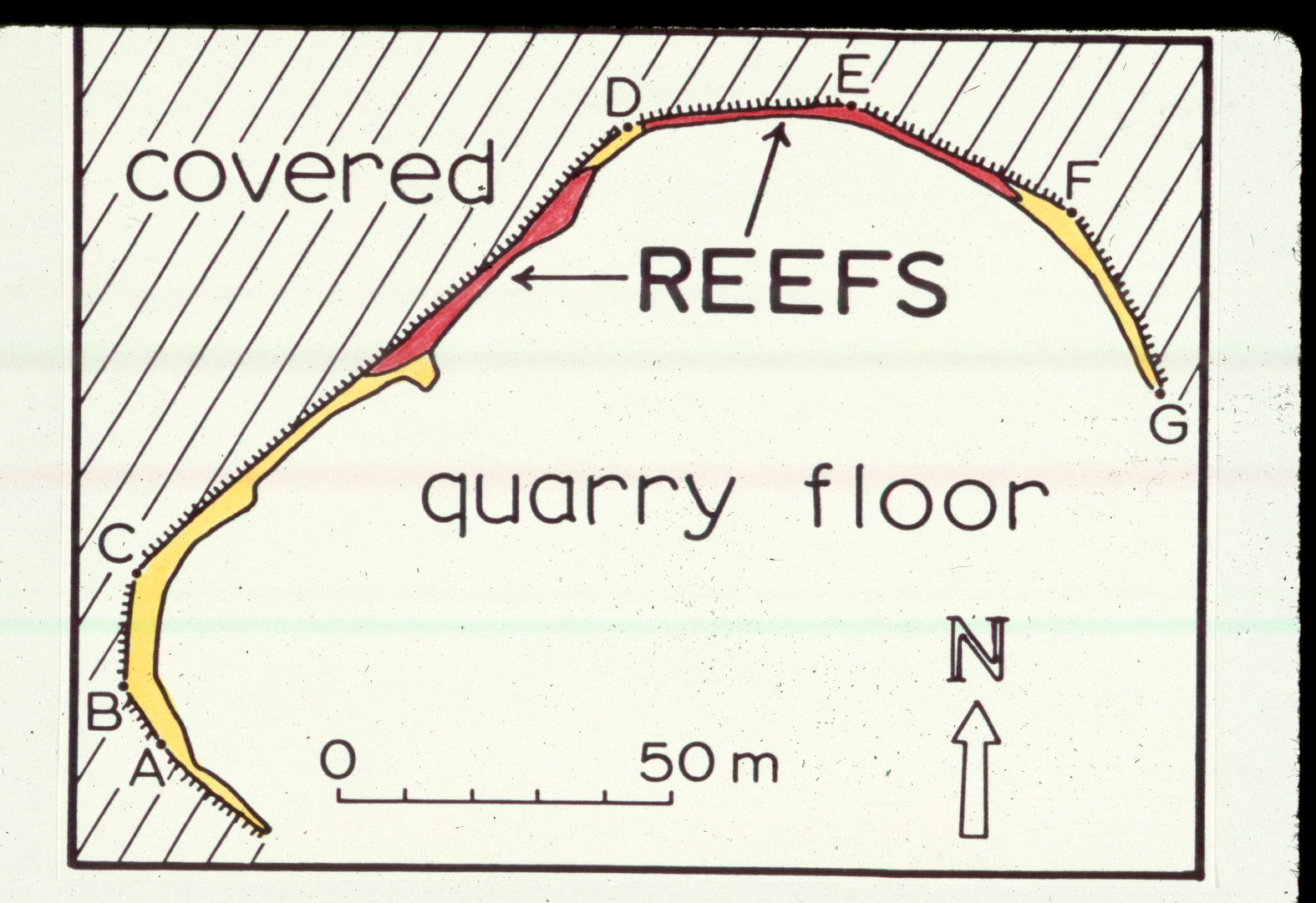
This geologic cross-section shows the different types of rocks present in the quarry wall at Lime Kiln Park in Grafton, WI. The location of measured section A, B, and C, which are illustrated on other pages, are shown on the cross section. Lower parts of the quarry face are covered by rock debris, soil, and vegetation. Exposed parts of the quarry face are formed by rock known as dolostone. Four subdivisions of the dolostone represent different environments of deposition related to development of the reefs.
© The Field Museum - CC BY-NC
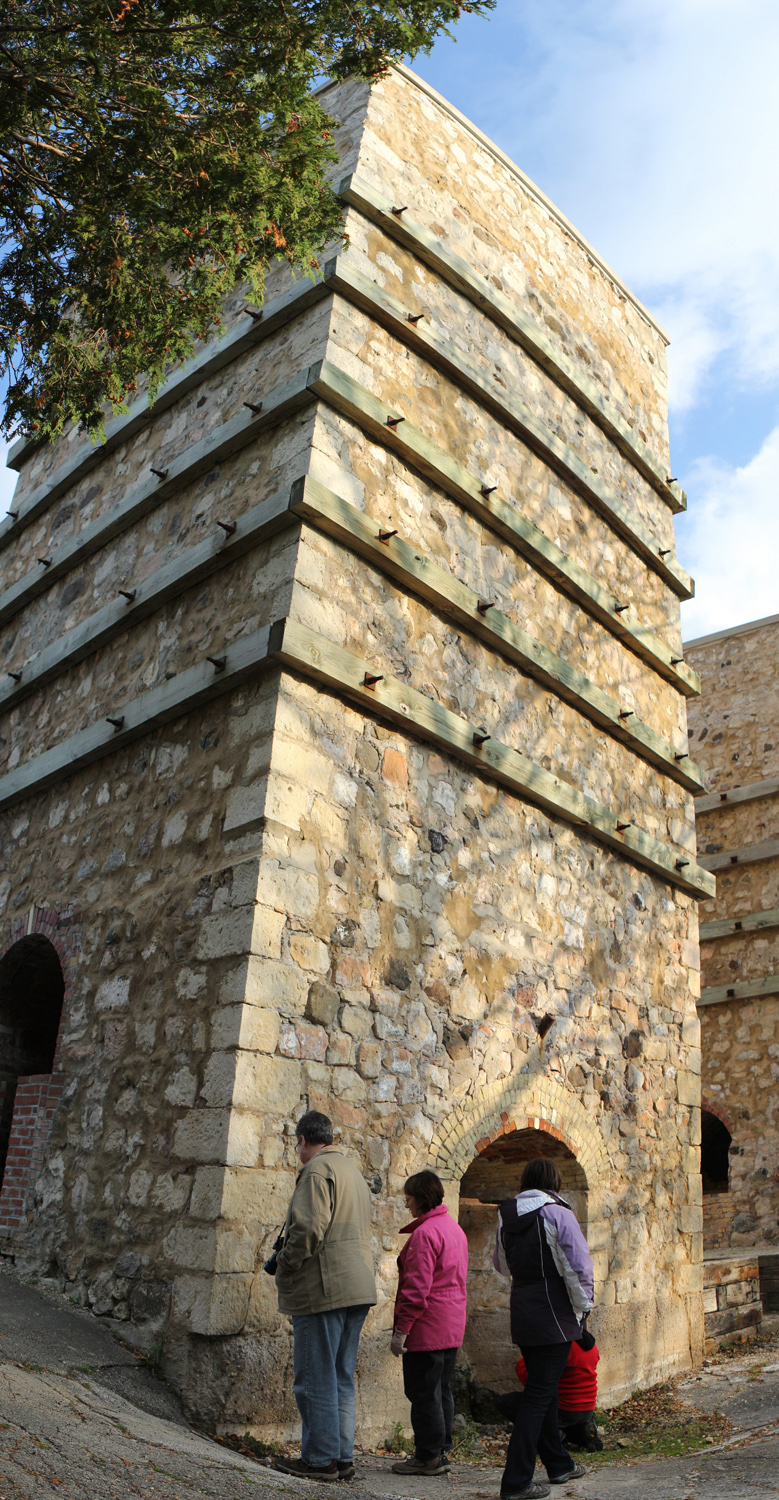
Paul Mayer, PJ Burke (MPM) and other museum staff exploring kilns near Grafton Silurian Reef site. Taken during November 2013 trip led by Paul Mayer to Silurian reef sites near Grafton, WI.
© The Field Museum - CC BY-NC
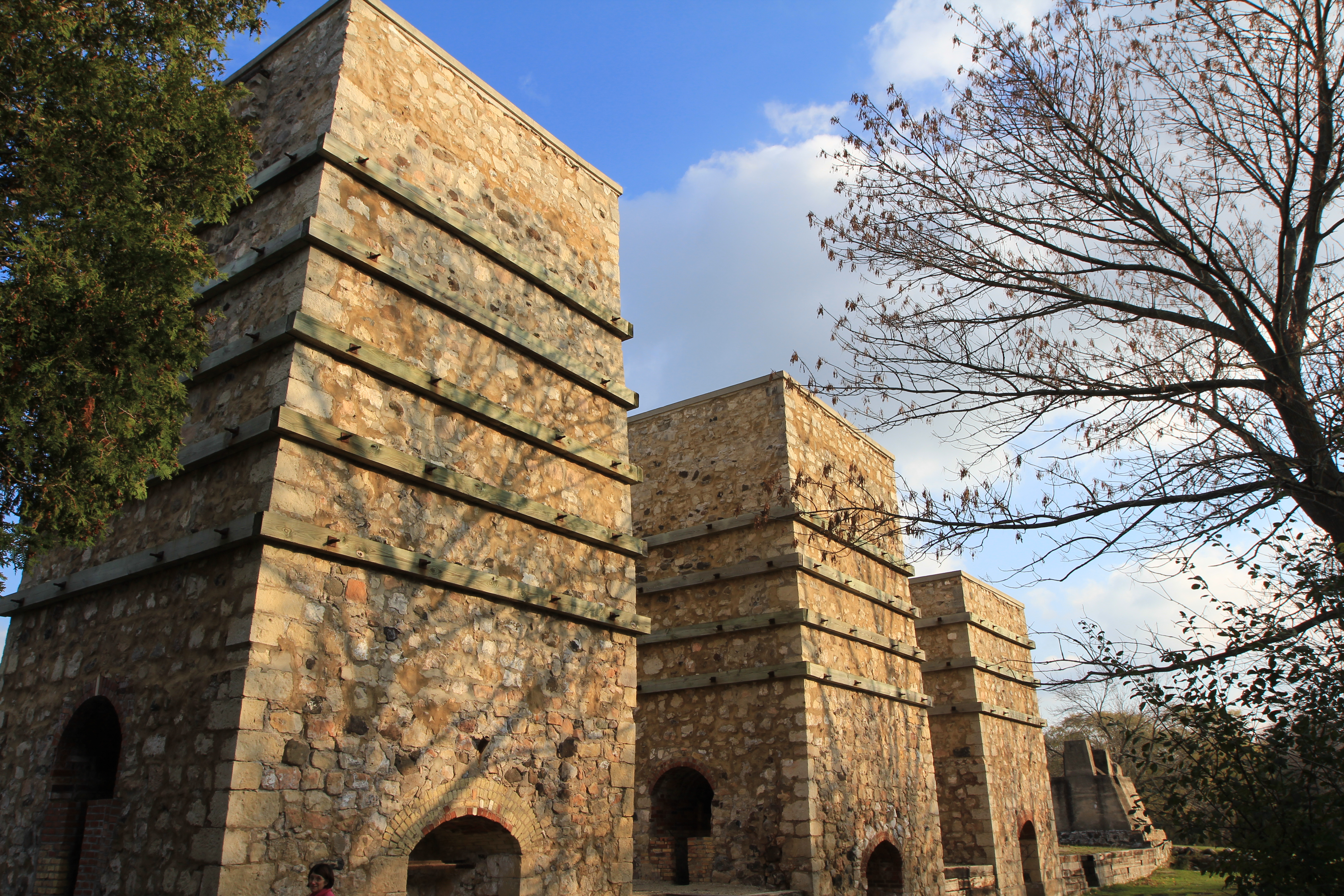
Lime Kilns at Lime Kiln County Park, Gafton, Wisconsin.
© The Field Museum - CC BY-NC



























